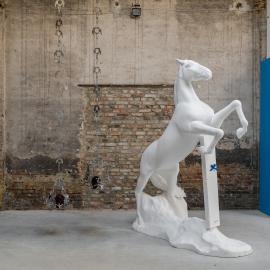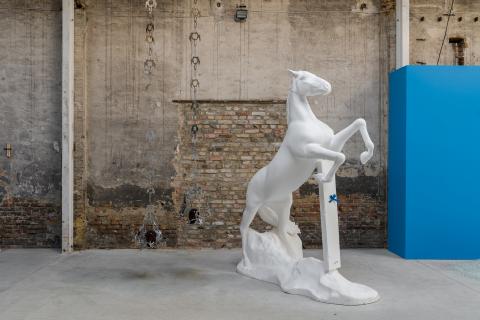Hannah Sophie Dunkelberg
@hannahsophiedunkelberghttp://www.hannahsophiedunkelberg.com/


Born 1987 in Bonn, Germany. Lives and works in Berlin, Germany.
Hannah Sophie Dunkelberg’s interest lies in the agency of her objects and the history of her materials. Her elements often act as reminders, an anecdotal quality is at play. But then she shifts the familiar into a material madness. In doing so, she investigates the interdependence between abstraction and meaning, social codes and cultural value.
Dunkelberg works in a lineage of artists who push against sculpture’s stability, dismantling the integrity of modernism’s status and re-mixing styles from industrial processes and craftsmanship. Dunkelberg’s work goes materially against the grain, her practice is labor-intensive and driven by an enthusiasm for material experimentation.
About the exhibited work
The installation „Sweet Little Lies“ comprises of a styrofoam horse sculpture and two metal lamps suspended from the ceiling. With a tongue-in-cheek sensibility, Dunkelberg restages her objects in an eerie scene: moving between the theatrical and what seems familiar, the artist reminds us that no object exists without association.
As a stale symbol of masculine domination, the horse brings to mind other anachronistic remnants like marble or bronze statues in public space or porcelain knick-knacks for the home. The artist uses styrofoam, a brittle, non-monumental material, to enshrine her monumental horse sculpture. Intentionally, Dunkelberg forgoes the use of metal or stone for a common modelling material that is light and temporal. Though designed to be lasting and permanent, the bronze skin of the horse eventually erodes; so too deteriorates the use of symbols and materials over time. Again, the artist asks: In what ways are our relationships to objects shaped by time and history? Can something be abstract and yet identifiable? Her sculptures dismantle kitsch and cliches, approaching the risky (and futile) condition of idolatry.
Dunkelberg’s lamps shine a dim light on these ideas: the interdependence between the historical and the everyday, the world as model instead of a grand stage of patriarchal monuments. A hopeful gesture: domestic to wild.
Hannah Sophie Dunkelberg’s interest lies in the agency of her objects and the history of her materials. Her elements often act as reminders, an anecdotal quality is at play. But then she shifts the familiar into a material madness. In doing so, she investigates the interdependence between abstraction and meaning, social codes and cultural value.
Dunkelberg works in a lineage of artists who push against sculpture’s stability, dismantling the integrity of modernism’s status and re-mixing styles from industrial processes and craftsmanship. Dunkelberg’s work goes materially against the grain, her practice is labor-intensive and driven by an enthusiasm for material experimentation.
About the exhibited work
The installation „Sweet Little Lies“ comprises of a styrofoam horse sculpture and two metal lamps suspended from the ceiling. With a tongue-in-cheek sensibility, Dunkelberg restages her objects in an eerie scene: moving between the theatrical and what seems familiar, the artist reminds us that no object exists without association.
As a stale symbol of masculine domination, the horse brings to mind other anachronistic remnants like marble or bronze statues in public space or porcelain knick-knacks for the home. The artist uses styrofoam, a brittle, non-monumental material, to enshrine her monumental horse sculpture. Intentionally, Dunkelberg forgoes the use of metal or stone for a common modelling material that is light and temporal. Though designed to be lasting and permanent, the bronze skin of the horse eventually erodes; so too deteriorates the use of symbols and materials over time. Again, the artist asks: In what ways are our relationships to objects shaped by time and history? Can something be abstract and yet identifiable? Her sculptures dismantle kitsch and cliches, approaching the risky (and futile) condition of idolatry.
Dunkelberg’s lamps shine a dim light on these ideas: the interdependence between the historical and the everyday, the world as model instead of a grand stage of patriarchal monuments. A hopeful gesture: domestic to wild.





